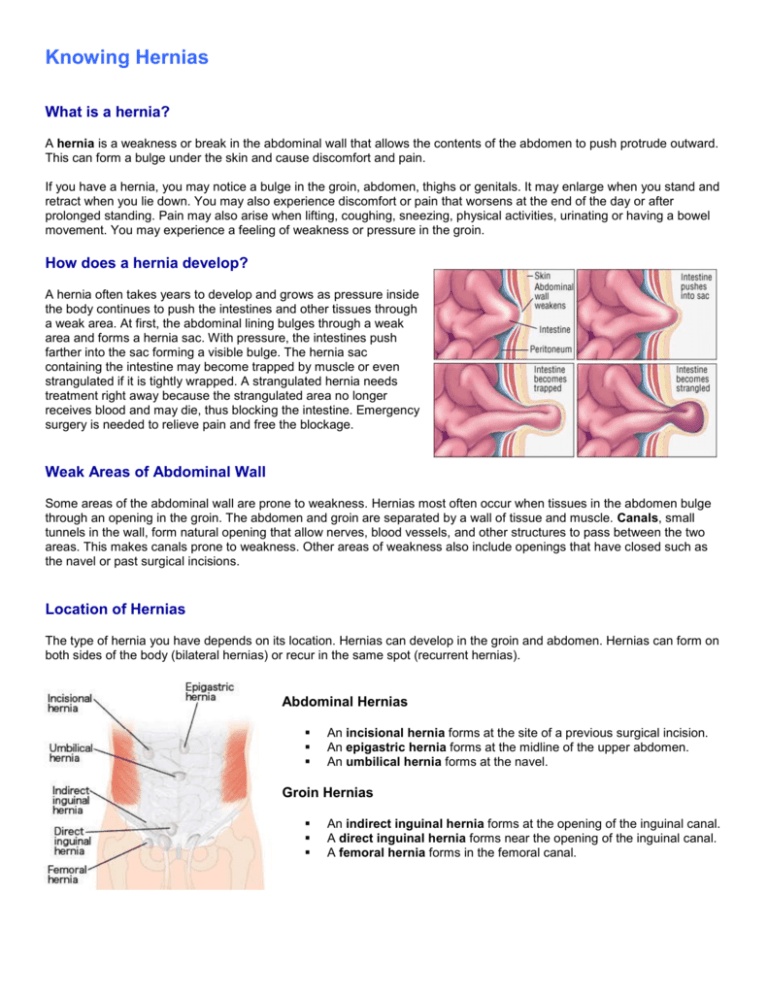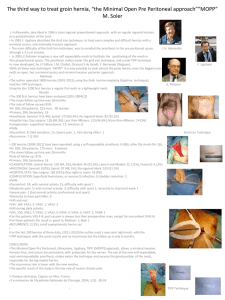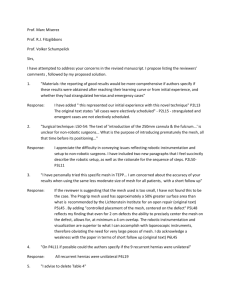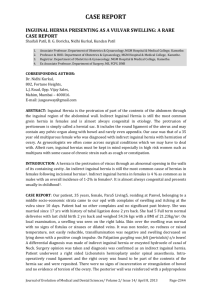File
advertisement

Knowing Hernias What is a hernia? A hernia is a weakness or break in the abdominal wall that allows the contents of the abdomen to push protrude outward. This can form a bulge under the skin and cause discomfort and pain. If you have a hernia, you may notice a bulge in the groin, abdomen, thighs or genitals. It may enlarge when you stand and retract when you lie down. You may also experience discomfort or pain that worsens at the end of the day or after prolonged standing. Pain may also arise when lifting, coughing, sneezing, physical activities, urinating or having a bowel movement. You may experience a feeling of weakness or pressure in the groin. How does a hernia develop? A hernia often takes years to develop and grows as pressure inside the body continues to push the intestines and other tissues through a weak area. At first, the abdominal lining bulges through a weak area and forms a hernia sac. With pressure, the intestines push farther into the sac forming a visible bulge. The hernia sac containing the intestine may become trapped by muscle or even strangulated if it is tightly wrapped. A strangulated hernia needs treatment right away because the strangulated area no longer receives blood and may die, thus blocking the intestine. Emergency surgery is needed to relieve pain and free the blockage. Weak Areas of Abdominal Wall Some areas of the abdominal wall are prone to weakness. Hernias most often occur when tissues in the abdomen bulge through an opening in the groin. The abdomen and groin are separated by a wall of tissue and muscle. Canals, small tunnels in the wall, form natural opening that allow nerves, blood vessels, and other structures to pass between the two areas. This makes canals prone to weakness. Other areas of weakness also include openings that have closed such as the navel or past surgical incisions. Location of Hernias The type of hernia you have depends on its location. Hernias can develop in the groin and abdomen. Hernias can form on both sides of the body (bilateral hernias) or recur in the same spot (recurrent hernias). Abdominal Hernias An incisional hernia forms at the site of a previous surgical incision. An epigastric hernia forms at the midline of the upper abdomen. An umbilical hernia forms at the navel. Groin Hernias An indirect inguinal hernia forms at the opening of the inguinal canal. A direct inguinal hernia forms near the opening of the inguinal canal. A femoral hernia forms in the femoral canal. Surgical Repair To treat the hernia, your doctor will repair the weakness in you abdominal wall. This can be done in different ways. The hernia can be repaired using a “tension free” mesh patch. The mesh patch is placed over the hernia and sutured to nearby tissues. A mesh plug can also fill the hole in the abdominal wall and then a mesh patch is placed above the defect. Lastly, your surgeon can use a combination device which placed mesh patches in front and behind the defect. The patches are connected by a mesh bridge that goes through the opening in the abdominal wall. This repair can be performed using laparoscopic surgery. This method is minimally invasive and uses a laparoscope or telescope attached to a camera. A carbon dioxide gas inflates the abdomen allowing your surgeon to work and surgical instruments are inserted through the incisions. Your surgeon may perform open surgery instead. He or she will use a larger incision to repair the hernia. Inguinal Hernias Inguinal (groin) hernias are common in both men and women. There are two types: indirect inguinal hernias and direct inguinal hernias. They either form at or near the inguinal canal, a tunnel connecting the abdomen and groin. Your surgeon may not be able to determine which type of inguinal hernia you have before surgery due to proximity in location. Indirect Inguinal Hernias An indirect inguinal hernia develops along the inside opening of the inguinal canal. With time, a bulge can form in the groin. Indirect inguinal hernias are very common in men. They can also occur in women. Direct Inguinal Hernias A direct inguinal hernia develops next to the opening of the inguinal canal. With time, a bulge can form in the groin. Men are more likely to develop a direct inguinal hernia. They can also occur at the same time as an indirect inguinal hernia. Repairing Inguinal Hernias Your surgeon will determine the best method to repair your inguinal hernia. He or she will use a tension-free repair which uses a mesh device. Your surgeon may use mesh patch. The mesh patch is placed in front or behind the defect and secured to nearby tissues. A mesh plug can also fill the hole in the abdominal wall and then a mesh patch is placed above the defect. Lastly, your surgeon can use a combination device which placed mesh patches in front and behind the defect. The patches are connected by a mesh bridge that goes through the opening in the abdominal wall. With time, new tissue grows into the mesh thus strengthening the repair and preventing new hernias from forming. Umbilical Hernias Umbilical hernias occur at the navel. They are common in adults and children of both genders. The hernia may be present at birth or form from an increase in abdominal pressure due pregnancy, frequent coughing, being overweight, or other factors. Repairing Umbilical Hernias Your surgeon will most likely use mesh patch. The mesh patch is placed in front or behind the defect and secured to nearby tissues. With time, new tissue grows into the mesh thus strengthening the repair and preventing new umbilical hernias from forming. Incisional Hernias Incisional hernias occur at the location of a pervious surgical incision. The intestines will bulge through the scar. This can occur months or years after the surgery. With time, the hernia can worsen, becoming more difficult to repair. These hernias can even become strangulated, muscles around the hernia wrap tightly around it causing a blockage in the intestine. Repairing Incisional Hernias Your surgeon will most likely use mesh patch. The mesh patch is placed in front or behind the defect and secured to nearby tissues. With time, new tissue grows into the mesh thus strengthening the repair and preventing new umbilical hernias from forming. Femoral Hernias Femoral hernias are very common in women. They form in the femoral canal, a tunnel connecting the legs and abdomen. These hernias are often small but they can still trap the intestine causing strangulation. Repairing Femoral Hernias Your surgeon will most likely use a mesh plug to fill the hole in the abdominal wall. Then a mesh patch is placed above the defect and secured to nearby tissues. With time, new tissue grows into the mesh thus strengthening the repair and preventing new femoral hernias from forming. Epigastric Hernias Epigastric hernias occur at the midline of the upper abdomen. The muscles and connective tissue of the area are prone to weakness. Repairing Epigastric Hernias Your surgeon will most likely use mesh patch. The mesh patch is placed in front or behind the defect and secured to nearby tissues. With time, new tissue grows into the mesh thus strengthening the repair and preventing new epigastric hernias from forming. Epigastric Hernia







